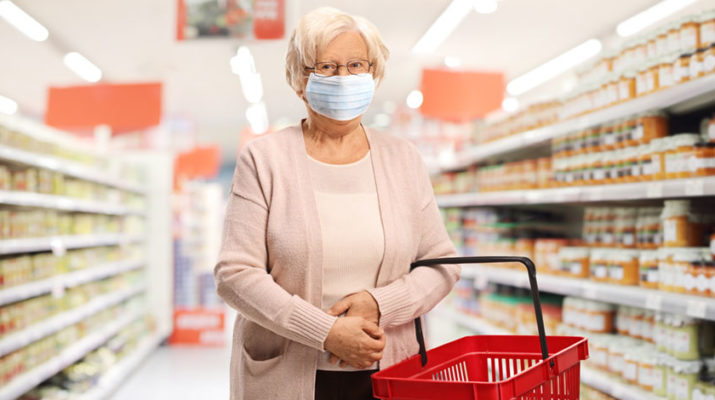By Deborah Jeanne Sergeant
Bustling crowds during coronavirus-fueled panic shopping may have presented an annoyance to some shoppers. But for an older adult with balance issues, going to stores during a time like this can increase the risk of falling and a subsequent broken bone.
Of course, during the pandemic, it’s important to follow health and safety protocols about going places in public; however, in general, a few strategies for shopping can make it safer to reduce the risk of falling for older adults.
Susan Schermerhorn, director of marketing at Ashton Place in Clifton Springs, recommended shopping at less busy times (see box with story).
Schermerhorn said that some Ashton Place residents who use a cane park near the cart corral and use the shopping cart for stability while walking. If possible, bringing along the cane in the cart can help if the shopper needs to step away from the cart.
Planning the route through the store can make the trip easier by reducing the need to backtrack.
“We outline the store near us by department — the way the store flows — so their list coincides with the store layout, Schermerhorn said. “It can save them time and exposure to germs.”
To save steps, shop online. Amazon Prime Pantry, for example, can deliver shelf-stable goods free with orders of $35 or more. That can whittle down the shopping list to fewer items.
Or shop with a store such as Wegmans, Tops and Price Chopper, which offer curbside pick-up or delivery through the Instacart app. This includes a store’s perishable goods, too.
Daniel Jones has a certificate in gerontology and owns Daniel Teaches. He teaches technology lessons, specializing in helping older adults access technology. Lately, he’s been developing online tutorials on apps such as Grubhub and Instacart.
“If you take your time and go through them, both are very straightforward,” Jones said.
Grubhub and DoorDash, a similar app, deliver restaurant food based upon ZIP code. Just enter the ZIP and see what restaurants use the delivery services.
“By default, it brings up menus for your area,” Jones said. “They may charge more because you live far away. There’s a point where the app itself is not going to work for you. But that will be pretty rare.”
Instacart works in a similar fashion, linking users to the stores nearest to the user, including grocery stores, mass merchandisers and drug stores.
While having someone else pick out your food may be an adjustment, “for the most part, when we all go shopping, we usually buy the same things,” Jones said. “I don’t need to check the back of the Ritz crackers every time. It’s a staple.”
Using an app for delivery “does cost a little more, but curbside usually doesn’t have a fee,” Schermerhorn said.
She added that since curbside groceries will be bagged in brown paper bags, which are more difficult to carry since they lack handles.
“Bring a reusable bag,” Schermerhorn said. “They could put the brown bags into the reusable bag so when you carry them to the house, you have a handle on them.”
Schermerhorn said that those with balance issues and concerns about stability should ask for help. Most stores have personnel available to reach items on high or low shelves or to load groceries, for example. Family members may also feel willing to help if they’re asked.
Once home, it’s okay to focus on putting away the perishable items and just leave the other items for later if fatigue is an issue.
Best Time to Grocery Shopping
Grocery stores are least busy before 8 a.m., according to InMarket, a company that analyzes retail shopping patterns. Once it’s noon, the store likely will stay busy until 7 p.m. As a plus, the store will likely be its cleanest and best-stocked early in the morning. Weekends, especially Saturday morning and early afternoon on Sunday (the post-church crowd) are very busy times, as are the day before a holiday or food-oriented event, such as the Super Bowl.
Shopping on weekdays — especially during morning working hours — is a much better bet for experiencing thinner crowds.
Tips for Safe Grocery Shopping
You’re in lockdown, yet you still have to go grocery shopping, but how do you stay safe and avoid catching the coronavirus?
The American Medical Association has some timely tips.
When you go to the store:
• Stay at least six feet away from other shoppers.
• Don’t shake hands, hug or have any physical contact.
• Wipe down grocery carts or basket handles with disinfectant wipes if you have them.
• Don’t touch your face.
• Wear a cloth face mask.
• While waiting and after leaving the store, use hand sanitizer if you have it.
• If you’re sick, don’t go shopping. But if you must, wear a mask, wash your hands often and keep a safe distance between you and others.
When you get your groceries home:
• Although it’s unlikely you’ll be exposed to the virus from the items in your shopping bag, wash your hands after unpacking your groceries.
• Wipe surfaces with a household disinfectant.
Take precautions when preparing food:
• Wash your hands before eating.
• Do not share plates or silverware with others.
• Rinse fruits and vegetables before eating them.
If you’re 65 or older:
• Ask a neighbor or friend to pick up groceries and leave them outside your house or bring them in while keeping at least six feet apart.
• Check with your local market and go during store hours reserved for older shoppers.
• See if your grocer delivers and shop online.
These tips were published online recently in the Journal of the American Medical Association.

